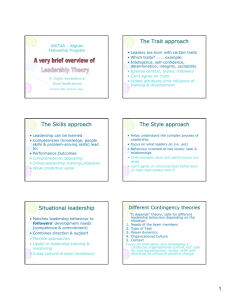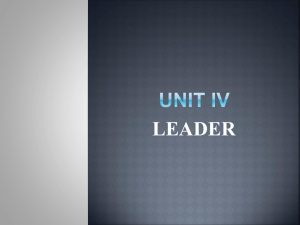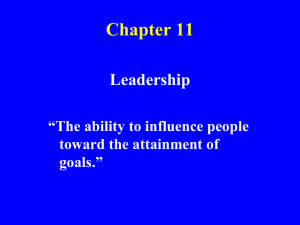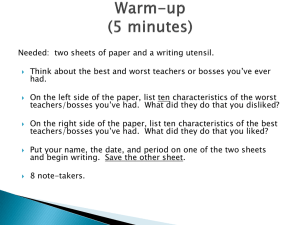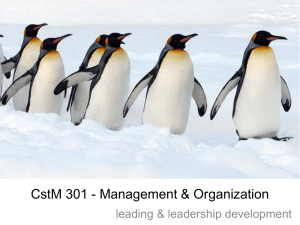UNIT IV -LEADERSHIP
advertisement
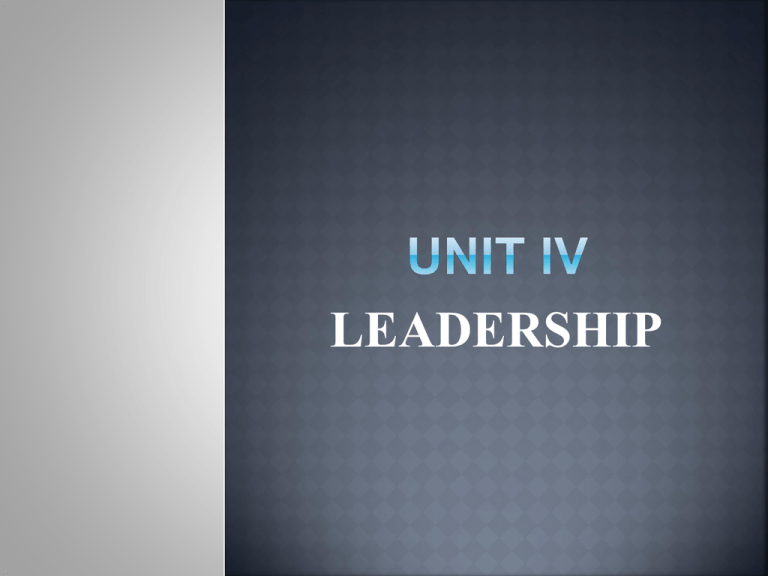
LEADERSHIP According to Hollander, “ Leadership is a process of influence between a leader and those who are followers” According to Hemphill & Coons “ Leadership is the behavior of an individual when he is directing the activities of a group towards a shared goal” According to Harry Truman, “Leadership is the ability to get other people to do what they do not want to do and like it” Leadership is the ability to inspire confidence and support among people who are needed to achieve organizational goals. It is a process that shapes the group goals and organizational goals,motivates behavior towards the achievement of these goals and helps to define groups or organizational culture. 1)Process of Influence: Leadership is a process whose important ingredients is the influence exercised by the leader or group members. A person is said to have an influence over others when they are willing to carry out his wishes and accept his advice, guidance and direction. Successful leaders are able to influence the behaviour,attitudes and beliefs of their followers 2) Continous Process: Leadership is not one time influence of subordinates or followers. In order to be a good leader, a manager should sustain the leadership continuously. Hence, once a leader does not warrant always a leader 3) Art and Science: Leadership is both art and science. Effective leadership requires both dimensions. Leadership is a science as it is concerned with the observation, study and classification of leadership practices which results in a reliable explanation of what makes leaders effective. Leadership is an art as it involves developing practical experience in the application of the leadership practices and methods resulting form the “science of leadership”. Thus, the art of leadership is about practicing the leadership science until one develops intuitions . 4) Related to Situation: Leadership is always related to a particular situation at a given point of time and under a specific set of circumstances. That means leadership styles will be different under different circumstances. 5) Function of Stimulating: Leadership is the function of motivating people to strive willingly to attain organizational objectives. Leaders are considered successful when they are able to subordinate the individual interests of the employees to the general interests of the organization. 6) Rational and Emotional: Leadership includes actions and influences based on reason and logic as well as those based on inspiration and passion. Since people are both rational and emotional, leaders can use rational techniques and or emotional appeals. 7) Community of Interests: There must be community of interests between the leader and his followers A leader has its own objectives. The followers have their own objectives. They are moving in different directions in the absence of community of interests. It is not advisable. It is the leader who should try to reconcile the different objectives and compromise the individual interests with organization interests. 8) Symbiotic Relationship: Leadership tends to focus almost entirely on the leader although without the followers, there is no leader. Leadership is symbiotic or participatory in the sense that leaders and followers exist in a mutual beneficial relationship where each adds to the effectiveness of the other. Subject Manager Leader Acting Doing things right Doing right things Focus Managing Things Leading People Approach Plans Detail Sets Direction Wants Results Achievement Avoids solitary work activity. Avoids close working relationships and conflict Is comfortable in solitary work activity; encourages close working relationships Power Formal Authority Personal Charisma Appeal Head Heart Feeling Engenders Fear Inspires Enthusiasm Objective Goal Oriented Feeds Imagination Relationship with others 11–6 Need for leadership arises because of the following reasons: 1)Imperfect Organisation Structure: It is not possible for any organization structure to provide for all kinds of realtionships.This explains the existence of informal groups within the framework of a formal organization. With effective leadership ,imperfection of a formal organization may be corrected and the formal and informal groups may be made to work in union 2) Technological, Economic and Social changes: In the phase of rapid technological, economics and social changes the organization is required to affect suitable changes in its operations and style. For eg: in the events of a fall in demand, it may discontinuous production of certain goods and services, or take up production of alternative goods and services. Only an effective leadership can enable it to meet the challenges posed b environmental factors. 3) Internal Imbalance Inspired by Growth: As an organization grows in size and complexity. It may develop certain imbalances. For eg: increase in organizational activities may lead to increase in the levels of management, thus adding to complexity of the Need for leadership arises because of the following reasons: of the organization structure, and problems of command, coordination and control work at all levels. Only an effective leadership can guide the organization through such situations. 4) Realign Organization: Leadership is needed to realign the organization with its customers and the business, and to overcome the tendency to become inwardly obsessed and self serving 5) Continuous Improvement: Leadership is needed to achieve continuous improvement of productivity and services for the consumer. These require innovation and investment in research and education,long range planning and focus on future. 6) Learning Culture: When culture becomes dysfunctional,leadership is needed to help the group unlearn some of its cultural assumptions and learn new assumptions. Leadership is important because it helps in : i) Effective direction: An organization comes into existence with certain objectives. To attain the objectives, the activities of the organization must be directed. Direction of the activities is effected through leadership. In short, effective leadership directs the activities of an organization towards the attainment of the specified organizational goals. (ii) Source of motivation: Leadership is the motivating power to group efforts. Effective leadership motivates the subordinates for higher productivity. (iii) Confidence: Leadership creates confidence in-the subordinates by giving proper guidance and advice. (iv) High morale: Good leadership increases the morale of the employees which, in turn, contributes to higher productivity. (v) Development of team spirit: Effective leadership promotes team-spirit and teamwork which is quite essential for the success of any organization. Leadership is important because it helps in : (vi) Encouraging initiative: A progressive, forward and democratic minded leader, always encourages initiative on the part of the followers. (vii) Overcoming resistance to change: A leader overcomes resistance, if any on the part of followers to organisational changes; through explaining to them the utility of such changes to both—the enterprise and the employees. (viii) Provide Aid to Authority: The use of authority alone cannot always bring the desired results. Leadership acts as an aid to authority by influencing inspiring and initiating action. Thus,authority when combined with leadership brings success to an organization. xi) Determining Goals: A leader performs the creative function of laying down goals and policies for the group he is leading. He also acts as a guide in interpreting the goals and policies. x) Rectifying Imperfectness of Formal Organizational Relationships: No organizational structure can provide all types of relationships and people with common interest may work beyond the confines of formal relationships. Such Informal relationships are more effective in controlling and regulating the behaviour of the subordinates. Effective leadership uses these informal relationships to accomplish the enterprise goals. Leaders have the following characteristics: 1)Communication towards people: Most team members are primarily concerned about relationships and about being valued as a team member before they are concerned about the task that the team is to undertake. Feeling secure in the group environment pre-requisite before individual contribution. The good team leader is able to spend time in building the team, not only when the team starts of, but when a new comer joins an existing team 2) Decide to support and service: Whilst team members want to see the ability to lead from the front they are also strongly motivated by ability to lead from the back . Servant leadership from the team leader is vital if team members want to serve each other. This is particularly key characteristics of team leaders 3) Enthusiastic,Energetic,Inspirational and Expert: Team members want to be motivated by team leaders, who have the energy and enthusiasm to fire them up. However, they also want to feel secure that the team leader has themselves, or has access to the necessary expertise to lead the team in the right direction. Leaders have the following characteristics: 4) Willingness to shoulder the responsibility: Team leaders are tested under pressure. When challenges arises, as they invitably will the leader will need to take responsibility to ensure that they are fixed as far as possible and the team is strengthened as a result.It does not mean that the leader should admit that issues beyond their control or in any way their fault, (although they should be honest in admiring their mistakes), but rather adopt a proactive attitude to ensure the team is not deflected from its course. 5)Ability to achieve more as a team: Teams only become a team once there is some synergy within the group i.e., the team process adds value to that which desperate group of individuals would achieve undirected. This is lightly to require the team leader to explore leadership models that share the leadership role with the team, to have an understanding of different individuals team roles, strength us and gives establish a mutual accountability within the team, and to create an team environment which is open, fun and allows healthy and productive discussion. 1)Develops team work: One of the primary function of the leader is to develop and combine his followers as a team. Given the followers competence, potential and needs. The leader needs to create an congenital and healthy working environment for his work team. 2) Serving as linking-pin : In Organisation, the leader serve as a linking pin between his/her team members and management. As and when required, the leader communicates the problems and grievance of the subordinates to the management, and also helps to solve problems by participating in problem solving process. 3) Provides guidance: when team members face problem in doing their work they seek guidance and advice from the leader. The problems may be technical or emotional in nature. 4) Manages time: Leader ensures the timely completion of activities undertaken by his/her team members. He appreciates the triat saying,” A stitch in time saves time” 5) Exercises Power: Leader exercises his power and authority over his subordinates as per the demand of the situation. Exercise of power needs to stimulate positive response from the subordinate 6) Improves Efficiency: The leader needs to provide for a reward system to improve the efficiency of capable workmen, delegate authority and invite participation of employees in decision making. Availability of necessary and adequate resources and communicating necessary information to the employees also helps leader to secure effectiveness of group effort. 7) Motivate workers: It is an important factor that induces the workers to perform well. Motivation will be effective of the employees understand the nature of work that is expected from each of them. 1)Great Man Theory 2)Trait Theory 3) Behavioural Theories - Ohio state Studies - Michigan Studies - Scandinavian studies - Managerial Grid 4) Contingency Theory : - Fiedler’s Least Preferred Co-worker (LPC) Theory - Cognitive Resource Theory 5) Situational Theory : - Hersey and Blanchard’s Situational Theory - House’s Path Goal Theory • - Leader Participation Model 1)Great Man Theory Leaders are born, not made. • This approach emphasized that a person is born with or without the necessary traits of leaderships. Early explanations of leadership studied the “traits” of great leaders “Great man” theories (Gandhi, Lincoln, Napoleon) Belief that people were born with these traits and only the great people possessed them According to the great man theory of leadership, leadership calls for certain qualities like commanding personality, charm, courage ,intelligence, persuasiveness and aggressiveness. Great Man approach actually emphasis “charismatic” leadership. charisma being the Greek word for gift. 2)Traits Theories of Leadership Theories that consider personality, social, physical, or intellectual traits to differentiate leaders from non-leaders Traits of Leaders Leadership Traits: • Intelligence • Ambition and energy • Physical Features • The desire to lead • Inner Motivation • Honest and integrity • Maturity • Self-confidence • Vision & Foresight • Intelligence • Acceptance of Responsibility • High self-monitoring • Open-Minded and adaptability • Self-confidence • Job-relevant knowledge • Human Relations Attitude • Fairness and Objectivity tual traits to differentiate leaders from non-leader 3)Behavioral Theories of Leadership Theories proposing that specific behaviors differentiate leaders from nonleaders. Pattern of actions used by different individuals determines leadership potential Eg: Democratic,Autocratic, and laissez-faire • Trait theory: Leaders are born, not made. • Behavioral theory: Leadership traits can be taught. Theories that attempt to isolate behaviors that differentiate effective leaders from ineffective leaders Behavioral studies focus on identifying critical behavioral determinants of leadership that, in turn, could be used to train people to become leaders BEHAVIOUR LEADERSHIP STUDIES: a)Ohio State Studies Initiating Structure The extent to which a leader is likely to define and structure his or her role and those of sub-ordinates in the search for goal attainment Consideration The extent to which a leader is likely to have job relationships characterized by mutual trust, respect for subordinate’s ideas, and regard for their feelings b)University of Michigan Studies Employee-Oriented Leader Emphasizing interpersonal relations; taking a personal interest in the needs of employees and accepting individual differences among members Production-Oriented Leader One who emphasizes technical or task aspects of the job c)MANAGERIAL GRID - BLAKE AND MOUNTON Appraises leadership styles using two dimensions: Concern for production Concern for people Impoverished Manager (1,1) - Exerts Minimum Efforts to get essential works done Country-club Manager (1,9) - Has high concern for people but low concern for production Authority-obedience Manager (9,1) – Has more concern for production but less concern for people Team Manager (9,9) – Has high concern for both production and people Organisation Man Manager (5,5) – Moderate levels of concern for both production and people The Managerial Grid (Blake and Mouton) d)SCANDINAVIAN STUDIES Development-Oriented Leader - One who values experimentation, seeking new ideas, and generating and implementing change. - Their premise is that in a changing world, effective leaders would exhibit development-oriented behavior. 4)CONTIGENCY THEORY: Contingency Theory deals with this additional aspect of leadership effectiveness studies. They are classified into Fiedler Model - Cognitive Resource Theory Hersey and Blencherd’s Situational Theory Leader-member Exchange Theory Path-Goal Theory Leader Participation Model a)Fiedler Model • The theory that effective groups depend upon a proper match between a leaders style of interacting with subordinates and the degree to which the situation gives control and influence to the leader. • There are basically three steps in the model 1)Identifying Leadership Style 2) Defining the Situation 3) Matching leaders and situations Fiedler Model - Identifying Leadership Style Fiedler believes a key factor in leadership success is the individual’s basic leadership style So he created the Least Prefer Co-worker (LPC) Questionnaire LPC:-An instrument that tells to measure whether a person is task or relationship oriented If the low LPC score then the person is task oriented If the high LPC score then the person is relationship oriented Fiedler Model -Matching leaders and Situations After knowing the leadership style through LPC and defining all the situations, we will chose the leader who will fit for the situation. Two ways in which to improve leader effectiveness 1) Change the leader to fit the situation 2) Change the situation to fit the leader b)Cognitive Resource Theory A theory of leadership that states that stress unfavorably effects the situation, and intelligence, and experience can lessen the influence of stress on the leader. A refinement of Fielder’s original model: Focuses on stress as the enemy of rationality and creator of unfavorable conditions A leader’s intelligence and experience influence his or her reaction to that stress Stress Levels: – Low Stress: Intellectual abilities are effective - High Stress: Leader experiences are effective Research is supporting the theory 5) Situational Theory: a)Hersey and Blanchard Theory A Model that focuses on follower “readiness” – Followers can accept or reject the leader – Effectiveness depends on the followers’ response to the leader’s actions – “Readiness” is the extent to which people have the ability and willingness to accomplish a specific task A paternal model: – As the child matures, the adult releases more and more control over the situation – As the workers become more ready, the leader becomes more laissez-faire Hersey and Blencherd identify four specific leader behaviors The most effective behavior depends on the follower’s ability and motivation If followers are unable and unwilling to do a task, the leader needs to give specific and clear directions If followers are unable and willing, The leader need to display a high task orientation. If the followers are able and unwilling, The leader needs to use a supportive and participative style. If followers are both able and willing, The leader doesnt need to do much. Situational Leadership Theory (SLT) A contingency theory that focuses on followers’ readiness. Also called as Life-Cycle theory of leadership. Unable and Unwilling Unable but Willing Able and Unwilling Able and Willing Follower readiness: ability and willingness Leader: decreasing need for support and supervision Directive High Task and Relationship Orientations Supportive Participative Monitoring Follower Readiness Able Willing Unwilling Supportive Participative Monitoring Leadership Styles Unable Directive High Task and Relationship Orientations 11–30 b)Path-Goal Theory The theory that it is the leader’s job to assist followers in attaining their goals and to provide them the necessary direction and/or support to ensure that their goals are compatible with the overall objectives of the group or organization. Leaders provide followers with information, support, and resources to help them achieve their goals – Leaders help clarify the “path” to the worker’s goals – Leaders can display multiple leadership types Four types of leaders: 1) Directive: focuses on the work to be done 2)Supportive: focuses on the well-being of the worker 3)Participative: consults with employees in decisionmaking 4) Achievement-Oriented: sets challenging goals Path-Goal Theory c)Yroom & Yetton’s Leader-Participation Model This theory is designed specifically to help leaders select the best approach to making decisions. The model identifies different ways a decision can be made by considering the degree of follower participation. It proposes a method for leaders to select the right approach to making a decision in a given set of circumstances. The model uses a decision-tree technique to diagnose aspects of the situation methodically. This technique involves answering a series of yes or no questions and following the yes path to the recommended type of decision-making approach. c)Yroom & Yetton’s Leader-Participation Model Decision tree This is an example of a decision tree. The Vroom-Yetton-Jago model utilizes decision trees to determine the best leadership style for a given situation. Autocratic or Authoritative Style Democratic or Participative Style Laissez-Faire or Free-Rein Style Autocratic Authoritarian Tells employees what they want done and how to do it. The subordinates have no opportunity to make suggestion or take part in decision-making function Generally, this style is not a good way to get the best performance from a team. Advantages - Reduced stress due to increased control -A more productive group ‘while the leader is watching’ - Improved logistics of operations -Faster decision making Disadvantages: - Short-termistic approach to management. - Manager perceived as having poor leadership skills - Increased workload for the manager - People dislike being ordered around - Teams become dependent upon their leader Democratic Participative style The leader involves one or more employees in the decision making process (to determine what to do and how to do it). Leader maintains the final decision making authority. Allows everyone to be part of a team everyone feels that they have participated and contributed. Motivates by empowering members Advantages - Positive work environment - Successful initiatives -Creative thinking Reduction of friction and office politics -Reduced employee turnover Disadvantages - Lengthy and ‘boring’ decision making - Danger of pseudo participation - Like the other styles, the democratic style is not always appropriate. It is most successful when used with highly skilled or experienced employees or when implementing operational changes or resolving individual or group problems. c)Free Reign (laissez faire) Leader allows employees to make the decisions. Leader is still responsible for the decisions. Employees analyze the situation and determine what needs to be done and how to do it. Leader sets priorities and delegates. Leader has little control. Team has little direction or motivation. This is an effective style to use when: - Employees are highly skilled, experienced, and educated. -Employees have pride in their work and the drive to do it successfully on their own. -Employees are trustworthy and experienced Disadvantages - It makes employees feel insecure at the unavailability of a manager. - The manager cannot provide regular feedback to let employees know how well they are doing. - Managers are unable to thank employees for their good work. - The manager doesn’t understand his or her responsibilities and is hoping the employees can cover for him or her. AUTOCRATIC STYLE - Adolf Hitler and his administration were responsible for the deaths of millions of Jewish people DEMOCRATIC STYLE; Indra Nooyi “Leadership is hard to define and good leadership even harder. But if you can get people to follow you to the ends of the earth, you are a great leader. As a leader, I am tough on myself and I raise the standard for everybody; however, I am very caring because I want people to excel at what they are doing so that they can aspire to be me in the future." Indra Nooyi in an interview to CNBC in June 2008. LAISSEZ-FAIRE : BARACK OBAMA ; A leader who leaves his/her colleagues to get on with their work. The style is largely a "hands off" view that tends to minimize the amount of direction and face time required. You two take care of the problem while I go. . .
